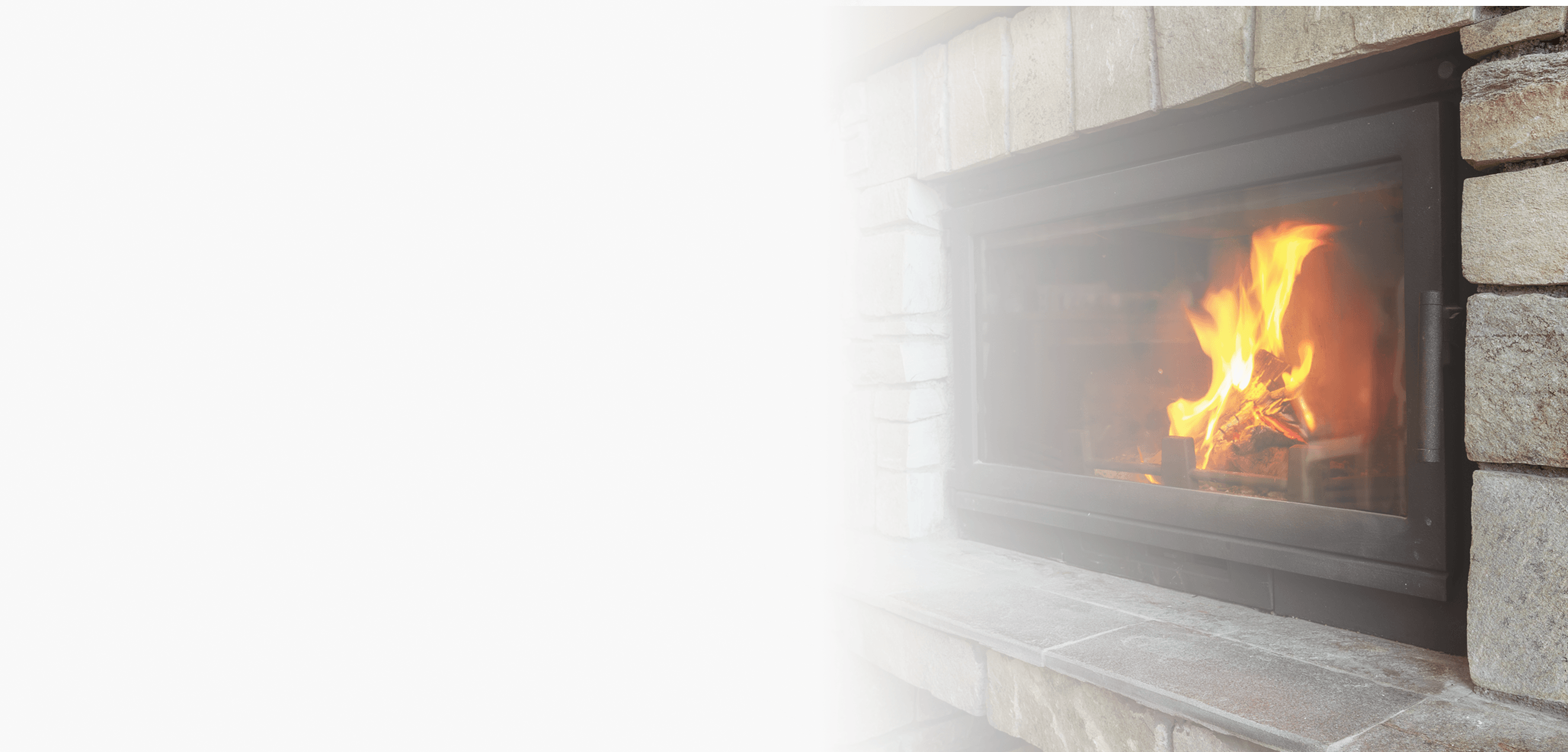Updated: November 13, 2025
Written by Dan Simms
Nieves is a home remodeling editor at Fixr.com with special interest in landscaping, pest control, painting, installation, and repair projects. She brings her work ethic, creativity, and love for teamwork into everything she does, including working with writers and designers at Fixr.com to develop useful and comprehensive guides for homeowners.
Learn moreReviewed by Nieves Martinez
Fireplaces make a wonderful addition to any home. They increase a home’s value, add to the visual appeal of a room, and even function as a supplemental heating source. Installing a fireplace is a complex and often expensive project, but it can be a worthwhile one in terms of home utility and long-term value.
The national average cost to install a new fireplace is $2,500, and most projects total somewhere between $1,000 and $5,000 for an electric fireplace. Your costs can vary widely based on the fuel source, the size of the fireplace, the surround material, the ventilation requirements, and more.
Cost to Install a Fireplace

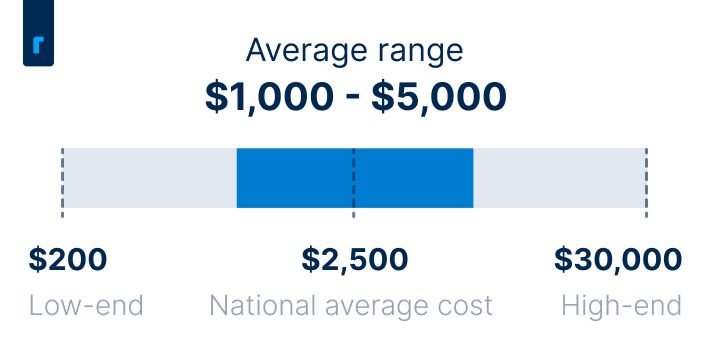
Fireplace Installation Cost by Type
The type of fireplace you choose is one of the most important factors to consider, as you could pay as little as $200 for a plug-and-play electric fireplace or as much as $30,000 to install a traditional wood fireplace due to the requirements for ventilation and a surround. Gas fireplace installation costs somewhere in the middle.
Keep in mind that the prices vary not only based on the actual cost of the firebox but also on the additional work required, like installing ventilation for wood-burning and gas fireplaces, which isn’t required for electric fireplaces.

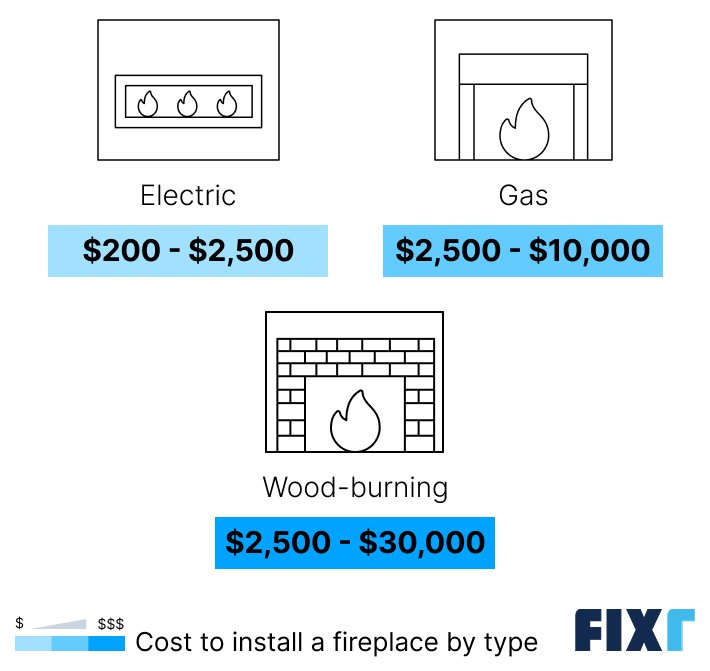
Type of Fireplace | Cost Range |
$200 – $2,500 | |
$2,500 – $10,000 | |
Wood-burning | $2,500 – $30,000 |
Electric
Installing an electric fireplace costs anywhere from $200 to $2,500. These self-contained units don't require fuel, ventilation, or a traditional chimney, making them a flexible option.
You can keep costs as low as possible by purchasing a freestanding electric fireplace and placing it in your space yourself. Costs can climb to $10,000 or more if you want a high-end electric fireplace that generates a lot of heat and is set into the wall, needs a new high-voltage outlet to support the addition, and includes a surround for visual appeal.
Gas
Gas fireplaces, which can run on either natural gas or propane, cost between $2,500 and $10,000 to install, in most cases. Costs can climb much higher if you’re also building a chimney, a hearth, and a fireplace surround to house your fireplace, so you can save money by simply setting your fireplace into a wall. Running a gas line to your home can also add significantly to your cost, so this option is more affordable if you already have gas in your home. Your final cost is heavily influenced by your choice of a vented or ventless model.
A vented gas fireplace requires a flue pipe or chimney to vent outside. This is a safer option because you don’t get potentially harmful gases or byproducts in your home, but it’s more expensive because you need to add the cost of installing a flue pipe.
Ventless gas fireplaces burn more cleanly but vent into your home, reducing indoor air quality, but they’re more affordable due to the simpler and less invasive installation. Note that ventless gas fireplaces aren’t legal in some areas, so you may not have an option at all.
Wood-Burning Fireplace Cost
Wood-burning fireplaces cost between $2,500 and $30,000 to install. The final price depends on whether you're installing a prefab model with an existing chimney or building a masonry fireplace and chimney from scratch. The cost climbs significantly for a new masonry build, especially if you need to pour a new foundation to support the added weight.
Installing a pellet stove in your home is a good alternative to fireplace installation. It provides more heat and costs an average of $3,000 to install. Just keep in mind that you don’t get the same warm and cozy view of a fire.
Fireplace Cost by Surround Material
It’s possible to install a fireplace without a surround, and this is a common option with freestanding electric fireplaces that can have built-in surrounds, as well as with some gas fireplaces and ethanol fireplaces if you’re going for a more modern look with the fireplace just set in the wall. However, if you want a more traditional and cozy look for your living room, you should expect to spend between $2.50 and $300 per square foot on the cost of a fireplace surround.
If you do opt for a surround, the material is going to be the most significant cost factor to consider. A small tile surround can start as low as $5 per square foot, while a custom floor-to-ceiling brick or stone surround can add $75 or more. More expensive materials like marble can push the cost to $300 per square foot or more.
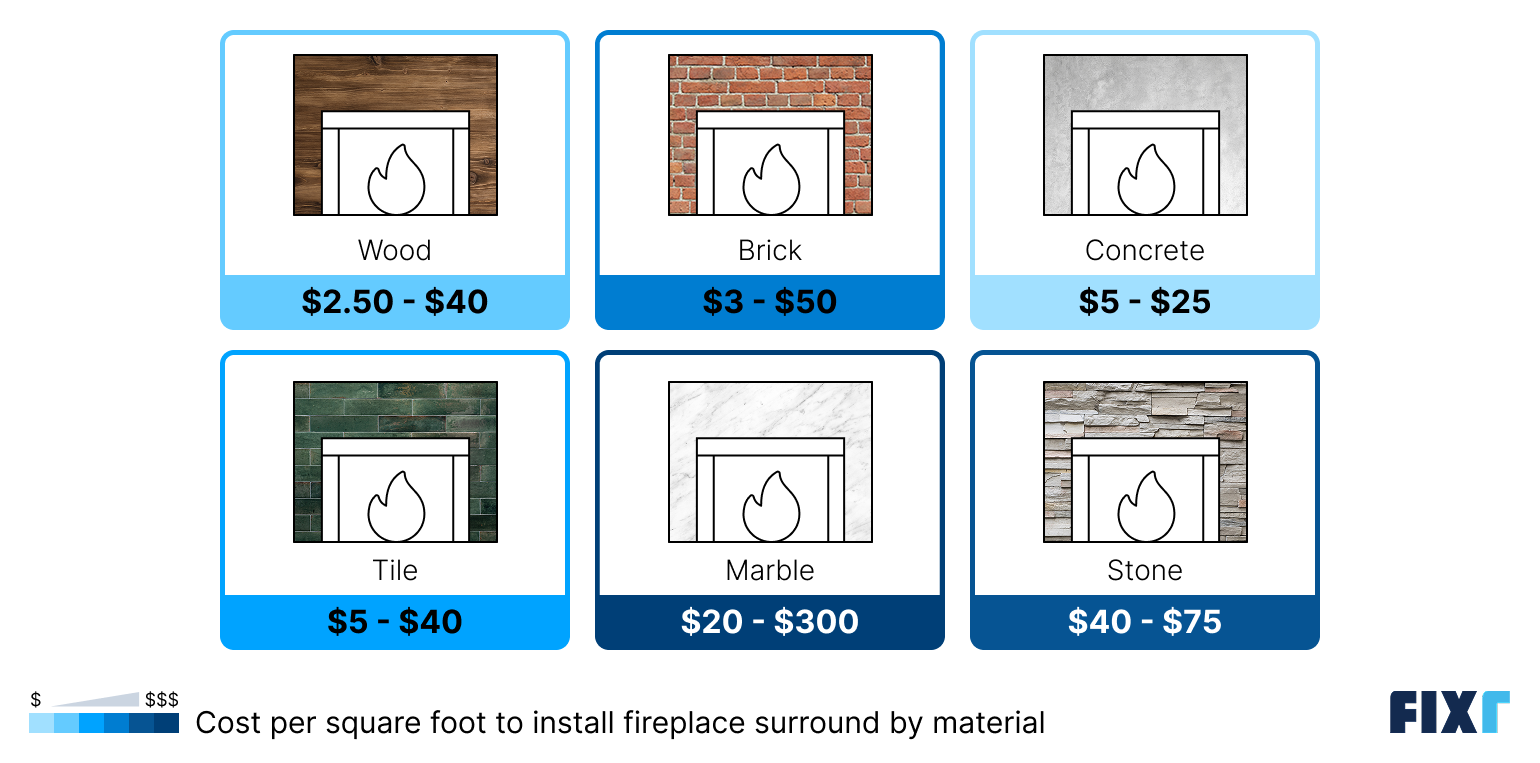
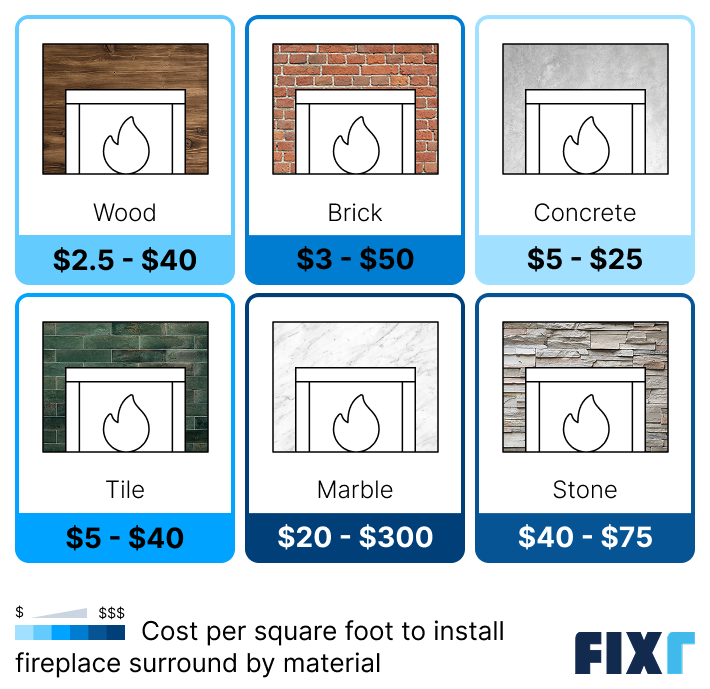
Surround Material | Cost Per Square Foot |
Wood | $2.50 – $40 |
Brick | $3 – $50 |
Concrete | $5 – $25 |
Tile | $5 – $40 |
Marble | $20 – $300 |
Stone | $40 – $75 |
Outdoor Fireplace Installation Cost
Installing an outdoor fireplace can enhance your backyard’s comfort and value. Most projects cost $1,500 to $8,000, though luxury custom builds with chimneys, seating, or full masonry surrounds can reach $50,000. While outdoor units don’t require ventilation, you may need to budget for a surround or even a small foundation, which can increase your overall cost.
Your final outdoor fireplace cost depends on several factors, including the type of fireplace, materials, and fuel source. A simple DIY fire pit can cost as little as $140, while permanent paver fire pits typically range from $1,500 to $5,000. Wood-burning options are the most affordable outdoors, whereas gas or propane fireplaces require trenching and fuel-line installation. Materials like pavers or basic masonry keep costs down, while custom brick or stone builds raise prices. Some projects may also need permits, which add $50 to $500.
Labor Cost
Labor costs to install a fireplace range from $200 up to $2,000, in most cases, but they can climb significantly higher. You’ll pay the lowest costs to have your pro install a fireplace insert, while you’ll see the highest prices if your project involves building a custom hearth and a genuine masonry surround built by hand.
Labor costs may also include installing proper ventilation for your fireplace and connecting gas lines, which can add hundreds or thousands to your price, depending on the location of your fireplace in your home.
Additional Costs and Considerations
There are some additional factors you should consider if you want the most accurate cost estimate possible.
Chimney and venting costs: If your chosen fireplace requires ventilation and you don’t already have a chimney or flue pipe, you’ll need to budget to add one of these options. Installing a chimney can add between $4,000 and $8,000 on average to your total. If you have an existing chimney, you may need to budget for repairs or relining, which typically cost $750.
Ethanol or gel fireplace: Installing an ethanol or gel fireplace costs between $700 and $1,400. They use alternative fuels that burn cleanly and don't require ventilation.
Fireplace insert: Installing a fireplace insert is a simpler, more affordable option since it fits inside an existing, nonfunctional fireplace and doesn’t usually require a new hearth or surround. Costs range from $700 to $6,500, depending on the unit and any additional work needed, such as chimney repairs, cleaning, or gas line installation for conversions.
Gas and electrical connections: Depending on the fireplace type, you may need additional utility work. Installing a gas line for gas or propane fireplaces adds $500 to $2,500 to your total, while adding or upgrading electrical wiring for an electric fireplace typically costs $175 to $500, especially if a 240-volt outlet is required.
Fireplace door, blower, and screen: If you have your pro build a custom fireplace, you might need to budget for fireplace door installation costs, fireplace screens, and fireplace blower installation costs for improved safety and performance.
Old fireplace removal costs: Expect to pay between around $4,500 to remove an existing fireplace before installing a new one. You’ll pay less if some of your old fireplace and chimney can be salvaged, but prices will climb higher if you need to start from scratch to get the fireplace you’re envisioning.
New installation vs. adding to an existing home: Installing a fireplace in new construction is more affordable than retroactively adding one to an existing home. New construction with open walls makes it easier to run gas lines and install flue pipes and chimneys, and there’s no demolition required beforehand.
Styles
Fireplaces come in a wide variety of styles, each offering a different way to shape the look and feel of a room. Whether you want your fireplace to blend seamlessly with the space or stand out as a statement piece, the style you choose can help define your home’s character. It also influences key factors like size, materials, and even fuel type, which all affect the overall installation cost. A sleek, built-in gas fireplace may suit a modern interior, while a traditional wood-burning model with a decorative surround and mantel might better complement a classic home design.
From sleek, minimalist looks to ornate and traditional designs, there’s a fireplace style to fit every aesthetic and budget. Simpler options, like modern farmhouse or craftsman fireplaces, work well in homes with evolving decor or neutral color schemes, while more decorative styles, such as Victorian, Art Deco, or Gothic, are perfect for those who want a bold focal point and cohesive design theme. Choosing the right style ensures your fireplace enhances not just the room it’s in but the overall atmosphere of your home.
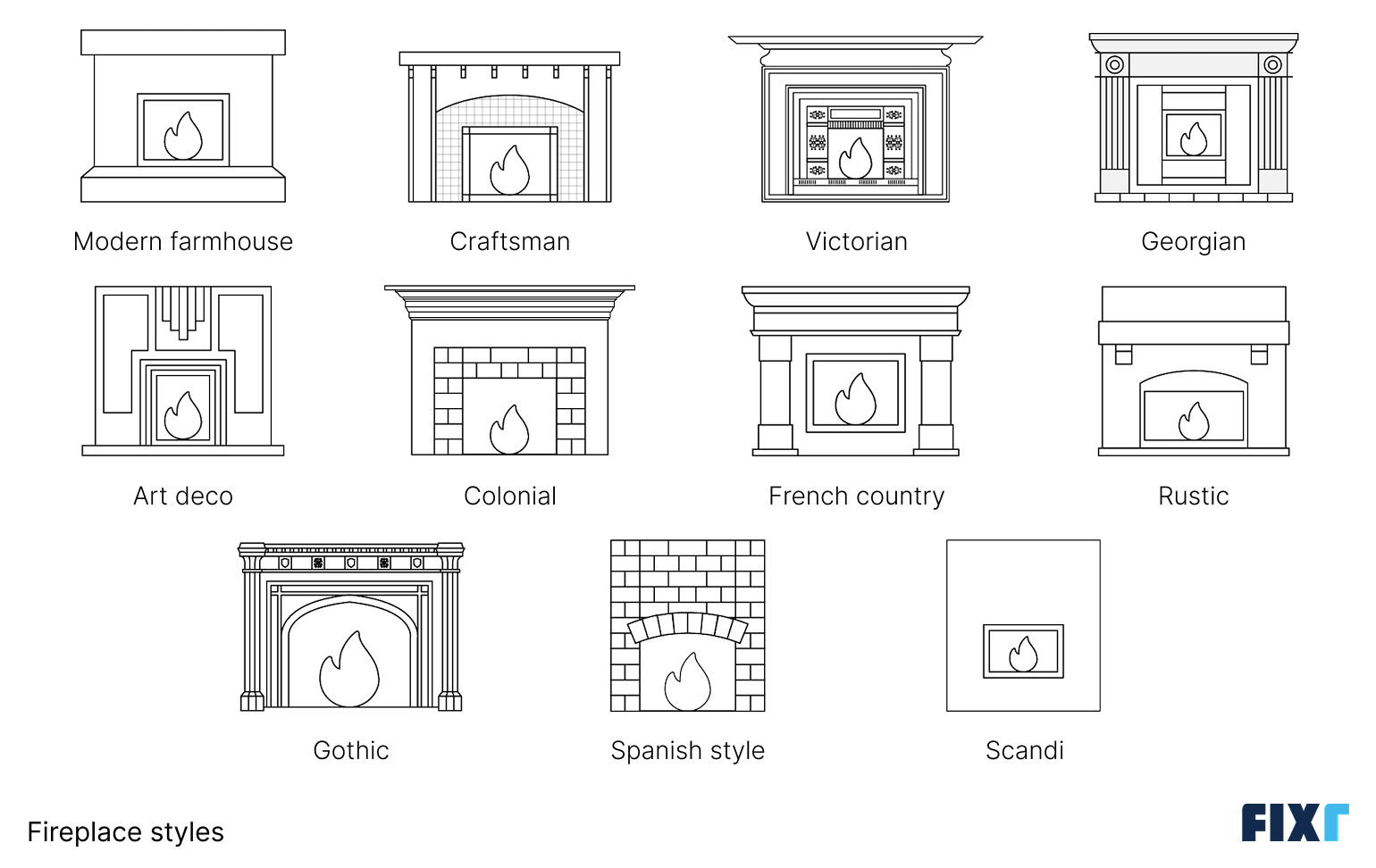
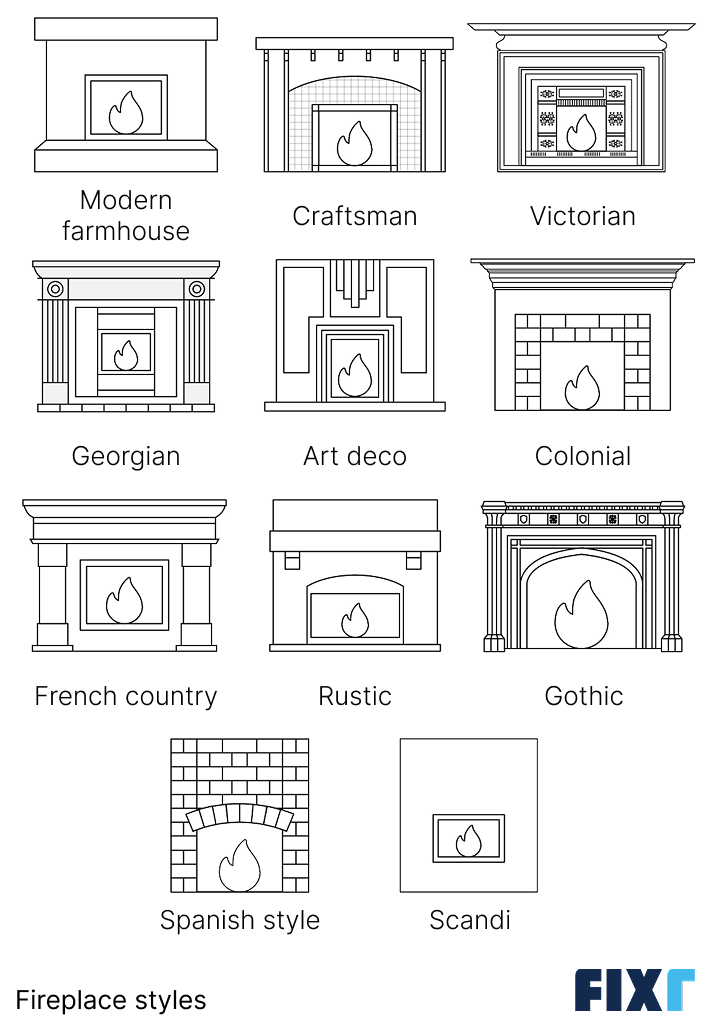
DIY vs. Hiring a Professional
If you’re just setting up a plug-in electric fireplace, then DIYing the installation is quick and easy, but anything more complex should be left to a professional. Installing a wood-burning or gas fireplace involves severe safety risks, and mistakes while installing the ventilation, hearth, and chimney can be deadly and lead to severe hazards, including gas leaks, carbon monoxide poisoning, and house fires. Also, a poorly done remodeling job can compromise durability and safety.
Professional installation ensures that the fireplace is properly sized, vented, and installed in compliance with all safety and local building codes, which is crucial for the safety of your home and family. Professionals will also have access to the right tools and expertise to handle the project, saving you from potential and often costly mistakes.
Benefits of Installing a Fireplace
Installing a fireplace can offer both practical and aesthetic advantages. Beyond adding charm and visual warmth to a home, a fireplace can increase comfort, energy efficiency, and even property value. Consider the following benefits to see the overall value you’ll get from this home improvement project.
Creates a cozy atmosphere: There’s nothing quite like curling up near a fireplace on a cold night or hearing the crackle of flames in the dead of winter. Fireplaces add warmth and comfort and can make your home feel more elegant.
Return on investment (ROI): The average return on investment (ROI) is between 6% and 12%. However, a fireplace may fetch a higher ROI in a colder climate, where use is more practical and can save money on home heating costs.
Increased property value: A fireplace is a highly desirable feature for homebuyers and can increase your property's market value.
A natural gathering spot: A fireplace can serve as a focal point in a room, encouraging family and friends to gather and connect.
Provides supplemental heat: A fireplace can help reduce your reliance on your central heating system, which can lead to lower utility bills and even lower ongoing maintenance costs for your HVAC system.
FAQs
The cheapest way to add a fireplace to your home is to purchase a freestanding electric fireplace and place it in your home yourself. Electric fireplaces don’t require any venting, and many come with built-in surrounds for visual appeal, which drastically decreases the cost of installing a fireplace. If you have a nearby outlet, you won’t even need to pay to have an electrician install one for you.
Yes, fireplaces add value to your home, and most homeowners can expect up to around a 12% return on investment. With average fireplace installation costs around $2,500, your home value could increase by up to $300. Your ROI could climb even higher in cold climates, where fireplaces are more desirable.
Yes, you can install a fireplace without a chimney, but you’ll be limited to specific types of fireplaces. Electric fireplaces and ventless gas fireplaces do not require a chimney, so these are popular options for homeowners who don’t already have a chimney in their homes.
Fireplace installation timelines vary widely depending on the type of fireplace and the complexity of the project. A simple electric fireplace installation may take a few hours, while a more complex project, such as installing a wood-burning fireplace with a new chimney, or a project that involves drywall work, could take up to a week. On average, most installations are completed within one to three days.
